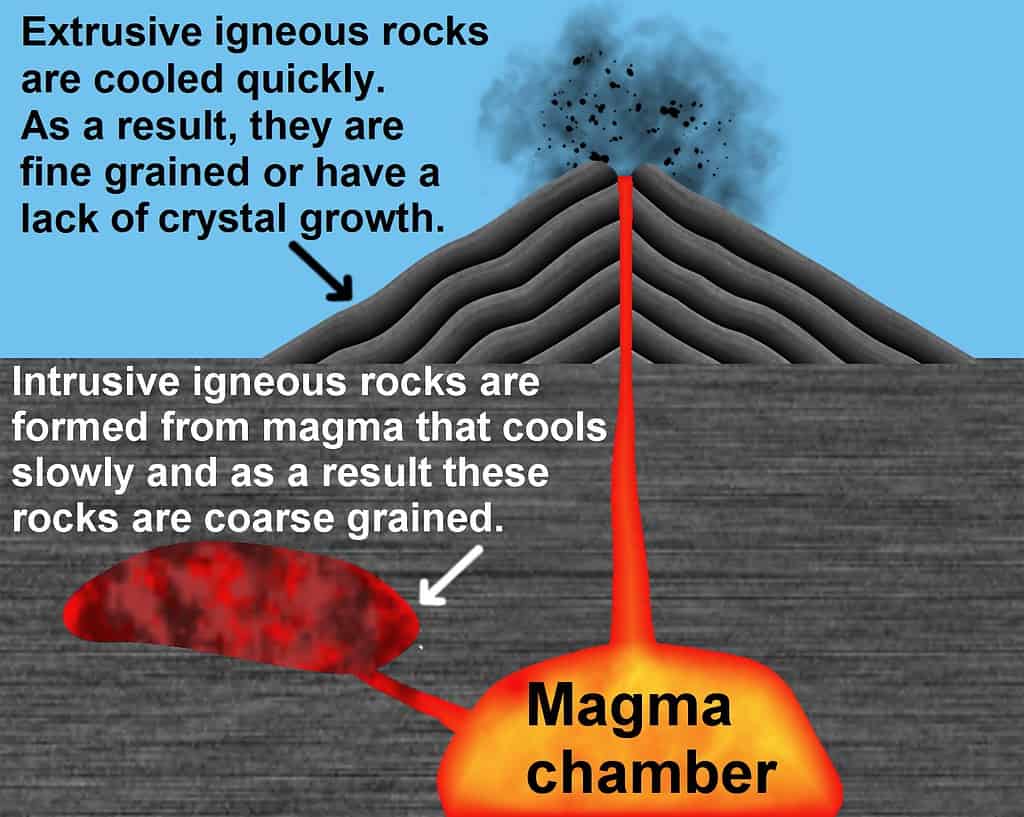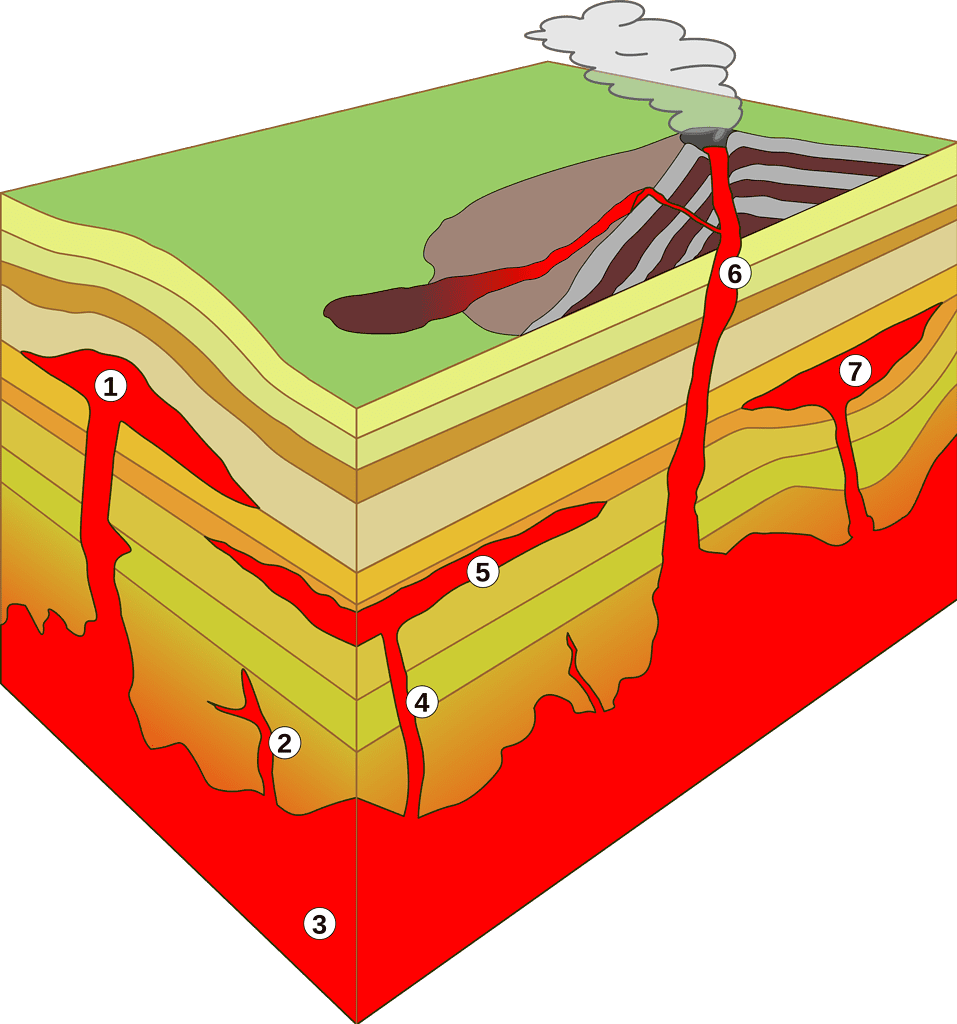Igneous rocks form from the cooling and solidification of magma, a molten rock material originating deep within the Earth’s mantle.
These rocks are classified into two main types based on where this cooling process occurs (consequently, this process decides how igneous rocks form).
- Intrusive rocks (also called plutonic igneous rocks) form beneath the Earth’s surface, where magma cools slowly, allowing large crystals to develop. This process results in rocks with big crystals like granite.
- Extrusive rocks (also called volcanic igneous rocks) form when magma erupts onto the surface (becoming lava) and cools rapidly, leading to finer crystals. Basalt, commonly found on ocean floors, is an example of an extrusive igneous rock.
The real story of igneous rocks, however, is much more exciting.

Igneous rocks first start in the mantle
Beneath the Earth’s crust lies the mantle, a layer of silicate rock that, while mostly solid, contains pockets of molten-like material known as magma. This magma is the birthplace of most igneous rocks. Formed from the partial melting of existing rocks in the mantle and crust due to intense heat and pressure, this molten material is the key ingredient in the igneous rock recipe.
Deep within the mantle, temperatures often soar above 1,000°C, causing solid rock to melt into magma. Sometimes, this molten rock, rich in minerals and gases, is less dense than its solid counterparts, setting the stage for a journey upwards. Other times, it is the convection currents in the mantle that push some parts of magma upwards. Either way, you need a mechanism to push magma towards the surface for igneous rocks to form.

This ascent can be a slow and gradual process, or it can happen rapidly during volcanic eruptions. The speed and path of this ascent play a crucial role in determining the type of igneous rock that will ultimately form.
The Two Types of Igneous Rocks: Intrusive and Extrusive
Based on how fast the magma or lava cools down, two types of igneous rocks emerge: intrusive and extrusive.

Intrusive Igneous Rocks: A Slow Cooling Process
Intrusive, or plutonic, igneous rocks form when magma cools and solidifies beneath the Earth’s surface. This slow cooling process, which can take thousands to millions of years, allows large crystals to grow. Granite, with its visible quartz, feldspar, and mica crystals, is a classic example of an intrusive igneous rock.
Extrusive Igneous Rocks: Rapid Surface Cooling
Conversely, extrusive, or volcanic, igneous rocks form when magma erupts onto the Earth’s surface, usually through a volcano.
When magma makes its way to the surface, erupting from volcanoes or fissures, it becomes known as lava. Upon reaching the cooler temperatures of the surface, lava undergoes a rapid cooling and solidification process. This quick transition from liquid to solid leaves little time for large crystals to form, resulting in a fine-grained or even glassy texture. Basalt and pumice are prime examples of extrusive rocks, each telling a story of volcanic eruptions and the swift sculpting of Earth’s surface.

The most extreme extrusive rocks don’t even have crystals — they cool down too quickly to have time to form crystals. This is what happens when a volcano erupts, for instance. A prime example is obsidian — a black, volcanic glass.
Differences between intrusive and extrusive igneous rocks
| Aspect | Intrusive Igneous Rocks | Extrusive Igneous Rocks |
|---|---|---|
| Formation Location | Below the Earth’s surface | At or near the Earth’s surface |
| Cooling Rate | Slow cooling due to insulation by surrounding rock | Rapid cooling due to exposure to air or water |
| Texture | Coarse-grained; large crystals due to slow cooling | Fine-grained or glassy; small or no crystals due to rapid cooling |
| Crystal Size | Larger crystals | Smaller crystals |
| Common Examples | Granite, gabbro, diorite | Basalt, andesite, rhyolite, pumice, obsidian |
| Visibility of Crystals | Crystals are often visible to the naked eye | Crystals may be too small to see without magnification |
| Color | Often lighter due to the presence of minerals like feldspar and quartz | Often darker due to rapid cooling and the presence of minerals like pyroxene |
| Gas Bubbles (Vesicles) | Few or none due to the slow release of gases | Common due to rapid cooling trapping gases |
| Formation Process | Magma cools and solidifies slowly in the Earth’s crust | Lava cools and solidifies quickly on the Earth’s surface or underwater |
| Exposure to Surface | Generally exposed by erosion and uplift over time | Immediately exposed to the Earth’s surface environment |
The primary distinction between intrusive and extrusive igneous rocks lies in their rate of cooling. This difference in cooling rates has profound implications for their structure, composition, and appearance.
Formation Location
Intrusive igneous rocks form beneath the Earth’s surface, within the crust. Their formation deep within provides insulation and leads to specific characteristics. In contrast, extrusive igneous rocks form at or near the Earth’s surface, including under ocean water, where they are directly influenced by external conditions like air and water.
Cooling Rate
The cooling rate is a significant differentiator. Intrusive rocks experience slow cooling due to being insulated by the surrounding rock. This slow process allows for distinct features in the rock. On the other hand, extrusive rocks cool rapidly as they are exposed to air or water, leading to different physical properties.
Texture and Crystal Size
These cooling rates directly affect the texture and crystal size of the rocks. Intrusive rocks develop a coarse-grained texture, with large, visible crystals, due to the slow cooling allowing more time for crystal growth. Extrusive rocks, conversely, have a fine-grained or glassy texture with small or no visible crystals, resulting from the quick cooling process which limits crystal growth.
Common Examples
Examples of intrusive rocks include granite, gabbro, and diorite, while extrusive rocks are represented by basalt, andesite, rhyolite, pumice, and obsidian. These examples reflect the diversity within each category.
Occurrence and Volcanic Activity
Intrusive rocks are not usually visible at the surface and are often exposed through erosion and tectonic activity. They are associated with plutonic activity, rarely reaching the surface. Extrusive rocks, however, are commonly found at or near volcanic regions, directly associated with volcanic eruptions and lava flows.
Density and Color
Intrusive rocks are generally denser due to their larger mineral crystals and often have a darker color. Extrusive rocks, in contrast, are less dense, with some (like pumice) being particularly porous due to trapped gas bubbles. Their color ranges widely, from the dark hues of basalt to the lightness of pumice.
Uses
The uses of these rocks also differ. Intrusive rocks, like granite, are widely used in construction for their durability, in items such as countertops and monuments. Extrusive rocks find use in lightweight aggregates, abrasives (like pumice), and landscaping.
Examples of how different igneous rocks formed
Let’s look at some examples of how various igneous rocks emerged.
- Granite (Intrusive): Forms deep underground from slowly cooling magma, allowing large crystals of quartz, feldspar, and mica to develop.
- Gabbro (Intrusive): Also forms beneath the Earth’s surface from magma but is richer in iron and magnesium, resulting in a darker, denser rock.
- Diorite (Intrusive): Develops from the cooling of magma that is intermediate in composition between felsic and mafic, leading to a mix of lighter and darker minerals.
- Basalt (Extrusive): Forms from the rapid cooling of lava that erupts onto the surface, typically from fissures or volcanoes, resulting in a fine-grained, dark rock.
- Andesite (Extrusive): Originates from the cooling of lava that is intermediate in composition, often found in volcanic arcs associated with subduction zones.
- Rhyolite (Extrusive): Forms from the rapid cooling of high-silica lava, leading to a light-colored, often glassy rock with fine crystals.
- Obsidian (Extrusive): Created when felsic lava cools so rapidly that no crystals can form, resulting in a glassy, usually dark-colored rock.
- Pumice (Extrusive): Produced from the frothy cooling of high-gas, high-silica lava, leading to a very light, porous rock that can float on water.
- Peridotite (Intrusive): Forms deep in the Earth’s mantle from slowly cooling magma, rich in iron and magnesium, and often contains olivine.
- Pegmatite (Intrusive): Develops during the last stages of magma cooling, often within granite bodies, leading to exceptionally large crystals of various minerals.


